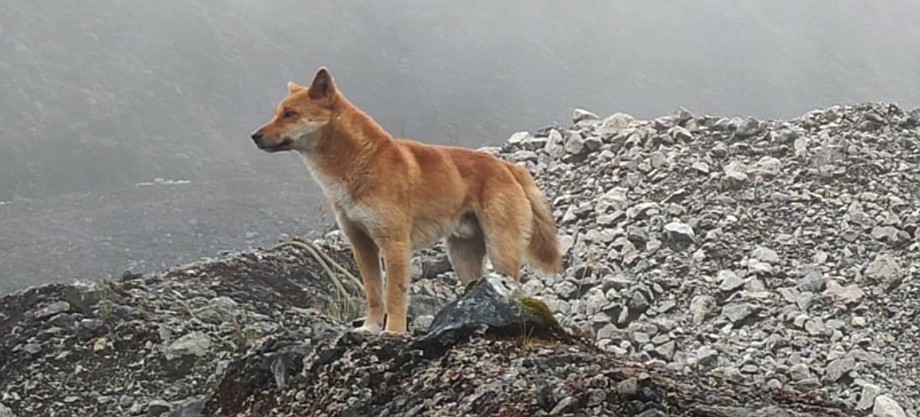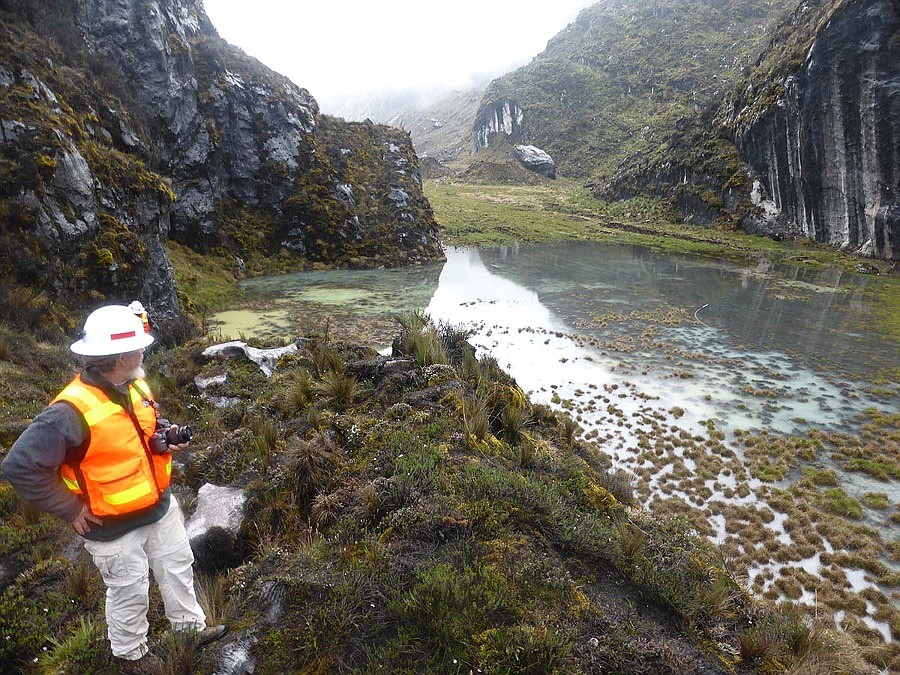Pursuing Singing Dogs
By LEIGH COOPER
University of Idaho
Twenty-five days into a search for singing dogs in New Guinea, James “Mac” McIntyre hadn’t seen a single one.
It was a particularly miserable day, drizzly and cold. The University of Idaho alumnus even decided to go barefoot through a boggy section of the trail to avoid traipsing around in wet boots for the rest of the day. While hiking to a 14,000-foot-high terrace, McIntyre played North American coyote calls in the hopes of attracting the reclusive singing canines to him or get a return call back.
But all day, nothing. No dogs.
Discouraged, McIntyre retraced his steps. And there, next to his muddy bare footprint, were two dog prints. He hadn’t found them. They found him.
The Search for an Extinct Species
Last sighted in the 1970s, New Guinea singing dogs, which have a unique high-pitched howl, were thought to be extinct in the wild. Today, a captive population of approximately 200 individuals exists.
But McIntyre wasn’t convinced that the dogs had disappeared from the island’s remote regions.
After an unsuccessful trip to New Guinea in 1996, the project stagnated until 2012, when an ecotourism guide snapped a picture of what appeared to be a wild singing dog in the remote highlands of West Papua. Four years later, McIntyre trekked into the New Guinea highlands on the Indonesian side of the island on a month-long trip to find highland wild dogs, which he believed to be the remnants of the island’s singing dog population.
“After 28 days, I had seen virtually nothing and I was pretty disappointed,” he said. “I had collected some old feces and heard a lot of stories and thought that was going to have to be good enough for me.”
On the last day of the trip, McIntyre collected his camera traps — cameras that had been busy the night before. They had captured more than 140 pictures of what appeared to be singing dogs. It was a tremendous victory, but McIntyre still didn’t know if these were the original New Guinea singing dogs or feral village dogs.
In 2018, he returned to the highlands to take DNA samples from the animals. By using lures, vocalizations and stinky baits, McIntyre attracted and trapped two dogs. He collected DNA from the two living animals — which were captured and released — and from one dog found deceased. The two captured dogs were also GPS collared. Genetic analyses showed that the wild highland dogs belonged to the same family line of canines as the captive New Guinea singing dogs.
Genes Tell the Story
McIntyre and his colleagues published their findings in Proceedings of the National Academy of Sciences in Fall 2020. The genetic samples indicated the founding population of captive singing dogs was not extinct but has been hiding in the remote highlands.
“The highland population has avoided hybridization in its remote location,” McIntyre said. “The singing dogs were not extinct in the wild. In fact, there are most likely healthy populations of these rare canids living at high elevations in remote areas of the island of New Guinea’s central mountain spine.”
The study showed the highland dog population has greater genetic diversity than the population of captive singing dogs, which originated from eight individual founders and is highly inbred. McIntyre hopes the genes of the highland wild dogs can rescue the captive community, which is in danger of going extinct if it continues with its limited gene pool. He wants to collect semen from the wild dogs on his next trip for infusion into the captive population.
The researchers also compared New Guinea dogs to other canines. Genetically, the highland wild dog, the captive New Guinea singing dog and the Australian dingo are nearly identical, according to the study. They are all descended from the ancestral Asian dogs that traveled, possibly with humans, throughout Oceania at least 3,500 years ago.
“This study is probably going to teach us about the evolution of dogs,” McIntyre said. “The New Guinea Singing Dog is an intermediate between today’s domestic dogs and the original wolf/dog on the planet. It’s going to tell scientists a lot about the migrations of people and their dogs throughout Asia and Oceania.”
Vandals Keep Adventuring
Now director of the New Guinea Highland Wild Dog Foundation and living in Fernandina Beach, Fla., McIntyre hopes to continue studying the highland population, collecting more DNA specimens and estimating the size of the wild population.
“This is very exciting for me because virtually nothing is known about the natural history of these dogs in the wild,” he said. “Everything that I learn is brand new and first of its kind. Not a lot of field zoologists get the opportunity to do this.”
McIntyre says his degree from U of I — a B.S. in zoology — gave him the foundation he needed to take his career to new heights. From there, it was grit, perseverance and his adventures in New Guinea that keep him going at age 66.
“The adventure for me is amazing,” McIntyre said. “We’d be up at 14,000 feet and completely surrounded by cold, rainy weather and socked in with fog, and we’d play singing dog or coyote vocalizations. To hear them return the calls through the fog and the mist — it is just magical.”



